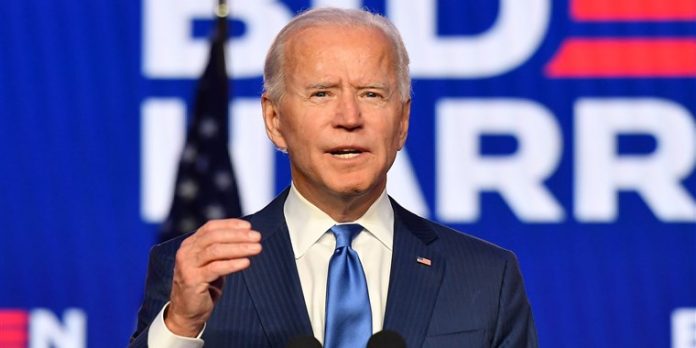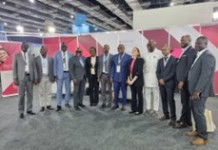By Amin Kef Sesay
On the 7th November 2020, Joseph R. Biden popularly known as Joe Biden was duly announced as the 46th President Elect of the United State of America after counting of votes in what has been described by many as a hotly contested Presidential race.
Under the ticket of the Democrat Party, Joe Biden, emerged victorious defeating Donald Trump, of the Republican Party, hands down.
Biden won by 273 Electoral Votes as against 214 Electoral Votes pulled by Donald Trump in an election in which the ultimate winner was expected to pull 270 votes in order to enter the White House.
The President Elect will be joined in office by Kamala Harris, who goes on to aid the Democrat Party as the Vice President of the United States. She has gone down the annals of history as the first female Vice President of the US.
During the electioneering period leading to the climax of the United States Presidential Election, polling day, on the 3rd November, 2020, journalists residing in different parts of the world were taken through an eight (8) weeks of virtual reporting on the build up to the very election, courtesy of the US Embassy in Sierra Leone.
Mark J. Rozell was the first speaker who dilated on the United States electoral system focusing mainly on Policy and Government. That was during Week one out of the eight weeks.
Touching on Federalism and Election in the United States, he informed that the US does not elect the national Government all in one year.
According to him, every two year the US elects the House of Representatives and 1/3 of the Senate and once every four years, the President is elected.
For this year’s 2020, election of the President, he stated, the House of Representatives and 1/3 of the Senate will take place.
On the 28th September 2020, which was Week 2, Mitchell S. McKinney dilated on The Role of Debates in the United States Presidential Election.
McKinney said that often when candidates take the stage, there is greater civility between them; which was not the case in 2016 when Trump and Hillary Clinton (Democrat) were nominated.
“Debates have shown their ability to reach that very small slice of the “undecideds”, “uncommitted”, the “persuadables”. And of that group consistently 3 per cent to 4 per cent will come out of a viewing debates, again, 3 per cent or 4 per cent of 87 million claiming that they now have committed, they now know who they’re going to vote for,” McKinney said during the briefing, noting that in this context, debates can be consequential in the outcome of the election in battle ground states.
There are different types of debates with different dynamics, McKinney said, noting how each of them provides different narratives about the candidates.
In the same Week 2, on September 30, 2020, a briefing was done by Sheila Krumholz on Campaign Finance. She said,”I feel pretty evangelical about the need for transparency in politics.” Sheila added that the money hardest to trace probably deserves a bit more security adding that one reason why CRP has become prominent is because the broader public is increasingly interested in campaign finance.
“I think people get that money are hugely influential,” Krumholz said. “It’s not everything … and yet, for the vast majority of races, about 90% of the races, the candidate who spends the most wins on election day.”
The African American Vote, with Dr. Lorenzo Morris, was done on the 1st October 2020 during Week 2 of the virtual reporting.
He said US President Trump refusal to condemn white supremacists during the recent debate is expected to create a significant impact on the Black votes.
Speaking to journalists Morris said the President’s controversial remarks could affect the overall vote of African Americans and other groups.
“And if you look at the media it’s clear that the media takes it as one that supports White supremacy. And, therefore, you can expect an impact on Black voting,” he said
During Week three (3) Joel Goldstein looked at the Role of the Vice President. He highlighted that the creation of the White House Vice Presidency is the most impressive development in American political institutions during the past four decades.
According to him, it has made robust an office that had generally been insignificant, and, in doing so, has contributed to the functioning of the presidency and American government.
“The enhanced Vice Presidency has emerged and endured without any new statutory or constitutional mandates,” he underscored maintaining how such a development shows that governmental institutions can change dramatically.
The Roles of TV Ads and Social Media were done by Joanna Weiss on the 7th October, 2020 during week three.
Talking to a select group of 225 journalists as part of a Foreign Press Centre ‘Virtual Reporting Tour’ on the role of TV ads and social media, Joanna Weiss, Contributing Editor, Politico Magazine, said the impact of social media on the voter was so high that about a year ago itself, Twitter had announced that it would ban all political advertising up to the 2020 election.
“Facebook makes a lot more money than Twitter in general on political advertising, so the stakes for that were much higher for them. Still, very recently Facebook announced that one week before the election on November 3, they will not accept new political ads,” she said.
Going into how social media was used by candidates and parties over the years, Weiss said one of the reasons that the Obama campaign did very well in 2008 was because it was one of the first presidential campaigns ever to make use of Facebook.
“Facebook was founded in 2004. It was a relatively new tool still in 2008, but one of Barrack Obama’s key strategists was one of the founders of Facebook and he and others helped the campaign understand how to use this platform as an organizing tool. Some media outlets called 2008 the Facebook Election. Little did they know what was coming,” she said, adding that in 2016, Donald Trump used Twitter in a different way and more effectively than any other candidate had before to bypass the media completely and get his message directly to the people.
What came next in week three (3) was “Election Security” and it was done by David Levine on the 8th October 2020.
He said election security is top of mind as they delve into the 2020 election cycle. From fighting fake news to preventing potential technical failures or cyber attacks on voter registration databases and voting equipment, to ensuring all voters have access to voting, the list of issues can seem overwhelming, he said.
Mr. Levine discussed recent examples of attempts by foreign entities to influence elections, and the security measures that have been implemented to combat them. He also presented a review of the U.S. election security issues that have been addressed to ensure a free and fair electoral process, from the primaries to the national elections.
During Week Four which dealt with Battleground States the briefing was done by Margie Omero and Jon McHenry. It was done on the 12th October, 2020.
They listed 12 Battleground States such as those flipped between the parties in 2015: Michigan, Wisconsin, Pennsylvania, Florida and Iowa and those that were decided by five points or fewer in 2016: Arizona, Nevada, Colorado,Minenesota, New Hampshire, Maine and North Carolina.
“Even States such as Georgia, Ohio and Texas that might have been ‘safe’ previously now they count as contested under different criteria,” added McHenry.
He maintained that the issues that matter in battleground States will be similar to what matters nationally adding that the Trump administration will be more focused on what voters would lose under a Biden presidency.
Also, he noted that the economy, Coronavirus and healthcare are major national issues.
“Polling and Analytics” followed next with Doug Schwartz on the 15th October, 2020.
Dr. Schwartz addressed journalists on polling and analytics on October 15. He said methodology is a very important indicator of the accuracy of a poll, and that there were polls in some key states that missed the mark.
“A major reason was that late deciders in those states wound up supporting Trump.” Schwartz explained. “Another reason was that some pollsters underestimated white voters without a college degree. It’s significant because these voters supported Trump and they were under counted in some polls in important states like Wisconsin, Michigan, and Pennsylvania, where Trump won by a very narrow margin.”
This meant that White voters with college education were overrepresented. Schwartz said that this was not the only reason the polls were a little off, but that pollsters have reassessed their methods, and are now weighting by education.
Countering Disinformation with Dr. Kathleen Hall Jamieson took place on the 16th October, 2020. Dr. Kathleen Hall Jamieson discussed methods and initiatives to detect and counter disinformation in this and previous elections, the impact of fact-checking, and other related topics.
Dr. Kathleen pointed out that the most high-profile disinformation campaign in recent years was Russia’s interference in the 2016 presidential election, in which it spread false and divisive narratives on social media that spread through traditional media and infiltrated political discourse.
“However, many other adversaries engage in disinformation, which often takes the form of concerted propaganda efforts. Government and industry, particularly traditional and new media outlets, seek to expose counter disinformation to ensure that information being proliferated online and in the news is indeed true,” Dr.Kathleen furthered
From what was highlighted, media outlets must establish policies for identifying and countering disinformation rather than rely on government to dictate a policy for them. Increase awareness of the issue: Studies show that if people know they are likely to be manipulated, they are more discerning about the information they choose to consume.
In Week Five (5) Dr. Lonna Rae Atkeson delivered on the “Mechanics of the Electoral College” which was held on the 20th October 2020.
She pointed out how the US has a highly arcane, indirect system of voting where voters do not elect the president. They choose presidential electors who then vote for the president and vice president.
According to Lonna Rae Atkeson, all ballot papers now omit the phrase “presidential electors” for all candidates that used to be on ballots. “Thus, many voters are unaware that they are not actually voting directly for a presidential candidate because it’s not clear on the ballot there if they’re voting for electors,” she said.
In each state, Democrats, Republicans and other minor political parties select their own “slate” of electors, which are put on the ballot.
Under the ‘winner take all’ practice, the party winning the popular vote – even by a narrow margin – gets the entire slate of electors. However, two states – Maine and Nebraska – have a district system of allocating electors. That means, two electors are allotted based on the winner of the state-wide popular vote, while the rest are based on the popular vote in the congressional district.
To win, a presidential candidate has to just attain a simple majority of 270 electoral votes.
“Women and the Election” with Christina Wolbrecht and Tierra Stewart came next on the 22nd October, 2020 during week five (5).
In the first several decades of women’s suffrage in the U.S., understanding of women’s political behavior was based on rhetoric, not based on data, said Wolbrecht. Data does show that married women often voted as their husbands did.
On the 23rd October 2020 Foreign Policy and the Election was discussed by Ambassador Charles Shapiro.
US Ambassador Charles Shapiro said during in the Foreign Press Centers program:
“Probably the one exception on foreign policy is that recent immigrant groups, of course, care about relations between the United States and their country of origin. The Indian Americans care tremendously about US-India relations and the same is true of Greek Americans, Turkish Americans, so there are groups that care way more about foreign policy, but they are a small percentage of the total voting population.”
Elizabeth Matto, during Week 7, which was on the 26th October, 2020, dilated on The Youth Vote .She said America’s youth vote is poised to make a real and dramatic impact on this year’s US presidential election – especially in key battleground states.
According to her, there are 88m young adults in the category of Generation Z and Millennials describing Millennials as those aged approximately between 23 and 38 who are in an alliance with the members of Generation Z born after 1997.
In terms of Election Day: What to Expect, Meena Bose predicted that Election night will last depending on the time when polls close and which States will be able to return results.
Bose was expecting to see a decision—or the absence of it—by 11 p.m. US eastern time or 12 noon of November 4, 2020.
“I think by about 11 o’ clock I would say on election night, we will know whether there is a decision or whether we need to wait to see the vote counts in states such as Pennsylvania, Michigan [and] if there are issues with vote counting in Florida,” Bose said during a Press Briefing organized by the US Department of State’s Foreign Press Centers.
“If the results are not decisive at that point, the decision could be known days later,” Bose said.






